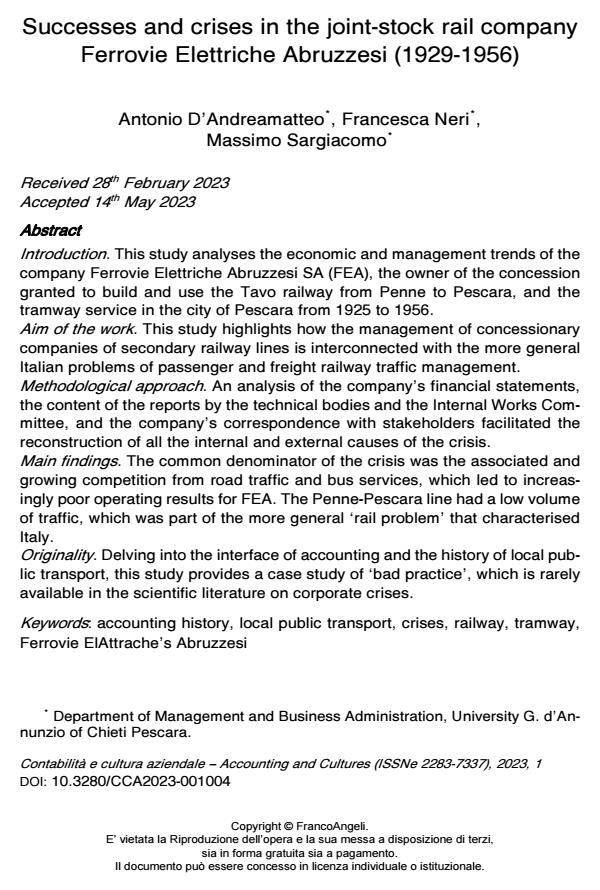Successes and crises in the joint-stock rail company Ferrovie Elettriche Abruzzesi (1929-1956)
Titolo Rivista CONTABILITÀ E CULTURA AZIENDALE
Autori/Curatori Antonio D’Andreamatteo, Francesca Neri, Massimo Sargiacomo
Anno di pubblicazione 2023 Fascicolo 2023/1
Lingua Inglese Numero pagine 26 P. 61-86 Dimensione file 135 KB
DOI 10.3280/CCA2023-001004
Il DOI è il codice a barre della proprietà intellettuale: per saperne di più
clicca qui
Qui sotto puoi vedere in anteprima la prima pagina di questo articolo.
Se questo articolo ti interessa, lo puoi acquistare (e scaricare in formato pdf) seguendo le facili indicazioni per acquistare il download credit. Acquista Download Credits per scaricare questo Articolo in formato PDF

FrancoAngeli è membro della Publishers International Linking Association, Inc (PILA)associazione indipendente e non profit per facilitare (attraverso i servizi tecnologici implementati da CrossRef.org) l’accesso degli studiosi ai contenuti digitali nelle pubblicazioni professionali e scientifiche
Introduction. This study analyses the economic and management trends of the company Ferrovie Elettriche Abruzzesi SA (FEA), the owner of the concession granted to build and use the Tavo railway from Penne to Pescara, and the tramway service in the city of Pescara from 1925 to 1956. Aim of the work. This study highlights how the management of concessionary companies of secondary railway lines is interconnected with the more general Italian problems of passenger and freight railway traffic management. Methodological approach. An analysis of the company’s financial statements, the content of the reports by the technical bodies and the Internal Works Committee, and the company’s correspondence with stakeholders facilitated the reconstruction of all the internal and external causes of the crisis. Main findings. The common denominator of the crisis was the associated and growing competition from road traffic and bus services, which led to increas- ingly poor operating results for FEA. The Penne-Pescara line had a low volume of traffic, which was part of the more general ‘rail problem’ that characterised Italy. Originality. Delving into the interface of accounting and the history of local public transport, this study provides a case study of ‘bad practice’, which is rarely available in the scientific literature on corporate crises.
Parole chiave:accounting history, local public transport, crises, railway, tramway, Ferrovie ElAttrache’s Abruzzesi
Antonio D’Andreamatteo, Francesca Neri, Massimo Sargiacomo, Successes and crises in the joint-stock rail company Ferrovie Elettriche Abruzzesi (1929-1956) in "CONTABILITÀ E CULTURA AZIENDALE" 1/2023, pp 61-86, DOI: 10.3280/CCA2023-001004